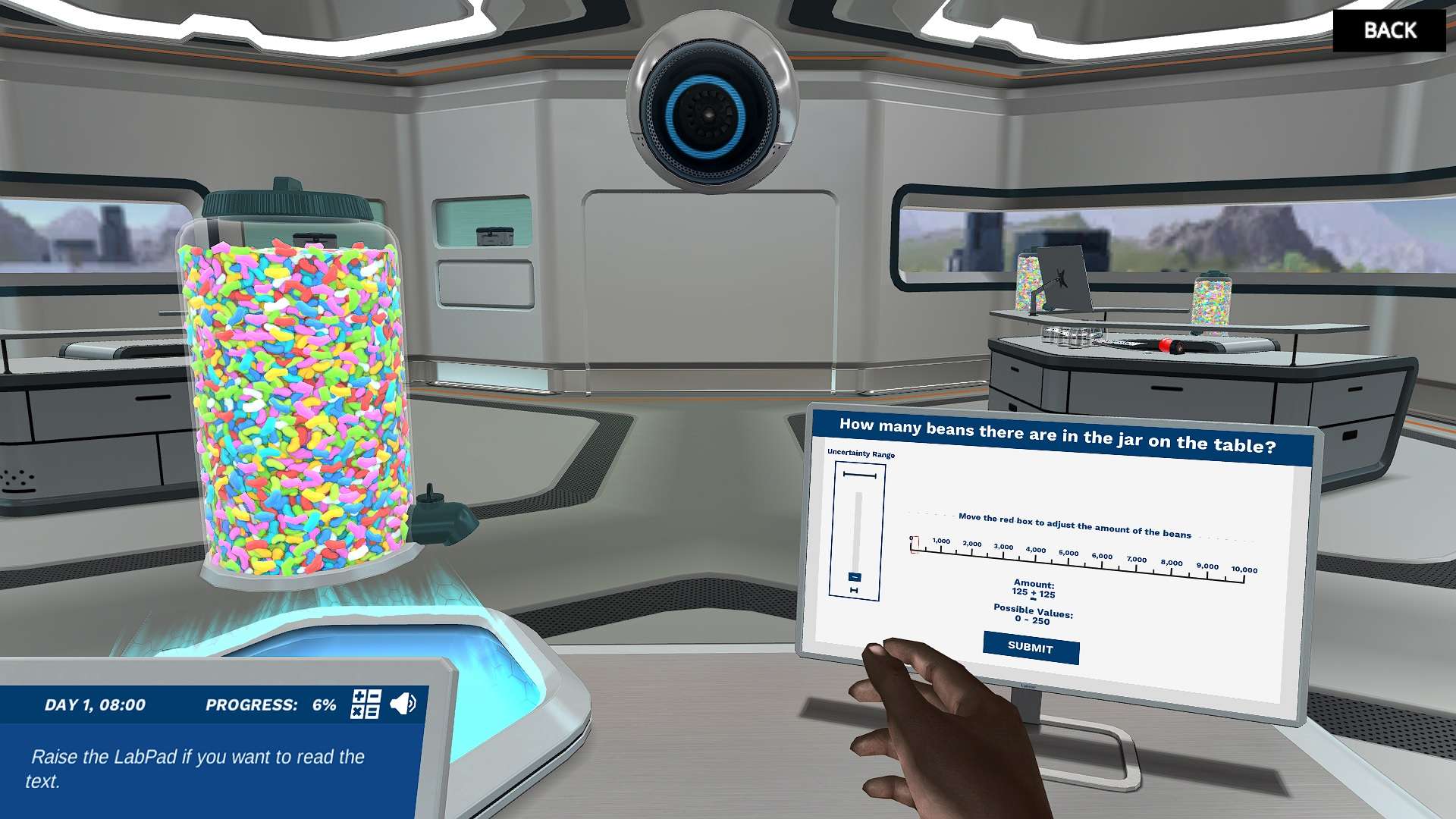Heading 1
Heading 2
Heading 3
Heading 4
Heading 5
Heading 6
Lorem ipsum dolor sit amet, consectetur adipiscing elit, sed do eiusmod tempor incididunt ut labore et dolore magna aliqua. Ut enim ad minim veniam, quis nostrud exercitation ullamco laboris nisi ut aliquip ex ea commodo consequat. Duis aute irure dolor in reprehenderit in voluptate velit esse cillum dolore eu fugiat nulla pariatur.
Block quote
Ordered list
- Item 1
- Item 2
- Item 3
Unordered list
- Item A
- Item B
- Item C
Bold text
Emphasis
Superscript
Subscript
About This Simulation
Take a scientific approach to the classic task of guessing how many candies are in a jar. Rather than random guesses, utilize good experimental design to select the correct measurement tools, continually refine the approach, and account for uncertainty in the data.
Learning Objectives
- Differentiate between instruments that give a reading and a measurement
- Select an instrument of appropriate resolution to perform a measurement
- Refine an experimental methodology to reduce its inherent uncertainty
About This Simulation
Lab Techniques
- Measurements and readings
- Calibration of tools
- Uncertainty calculations
Related Standards
- ETS1.A-H1
Learn More About This Simulation
Now more than ever, it’s important for scientists to understand how much they can trust their results, when to disregard or accept them, and how to improve their reliability. In this simulation, you’ll learn how to select the right tool for carrying out an experiment and how to refine an experimental methodology to reduce its inherent uncertainty.
How Many Candies in the Jar:
In this simulation, you will start by coming up with a guess including an uncertainty range. Through making this guess, you’ll gain an appreciation of the difficulties scientists face in the real world, and the errors associated with their experiments.
Measurements and Readings:
Tools that produce measurements must be calibrated first, while tools that produce readings are assumed to be already calibrated. Students will learn about these differences and classify various experimental tools during this mission.
Refining the experimental methodology:
Choose between two different approaches to scientifically guess how many candies are inside the jar. In each of the methods, you’ll address the potential errors and uncertainty that may occur in your approach.
Deciding on the correct figure:
After you refine your experimental methodology and account for all the uncertainty you think you’ve uncovered, you’ll perform some calculations to decide on the number of candies that are in the jar. After the big reveal, you’ll find out how close you are.
For Science Programs Providing a Learning Advantage
Boost STEM Pass Rates
Boost Learning with Fun
75% of students show high engagement and improved grades with Labster
Discover Simulations That Match Your Syllabus
Easily bolster your learning objectives with relevant, interactive content
Place Students in the Shoes of Real Scientists
Practice a lab procedure or visualize theory through narrative-driven scenarios


FAQs
Find answers to frequently asked questions.
Heading 1
Heading 2
Heading 3
Heading 4
Heading 5
Heading 6
Lorem ipsum dolor sit amet, consectetur adipiscing elit, sed do eiusmod tempor incididunt ut labore et dolore magna aliqua. Ut enim ad minim veniam, quis nostrud exercitation ullamco laboris nisi ut aliquip ex ea commodo consequat. Duis aute irure dolor in reprehenderit in voluptate velit esse cillum dolore eu fugiat nulla pariatur.
Block quote
Ordered list
- Item 1
- Item 2
- Item 3
Unordered list
- Item A
- Item B
- Item C
Bold text
Emphasis
Superscript
Subscript
A Labster virtual lab is an interactive, multimedia assignment that students access right from their computers. Many Labster virtual labs prepare students for success in college by introducing foundational knowledge using multimedia visualizations that make it easier to understand complex concepts. Other Labster virtual labs prepare learners for careers in STEM labs by giving them realistic practice on lab techniques and procedures.
Labster’s virtual lab simulations are created by scientists and designed to maximize engagement and interactivity. Unlike watching a video or reading a textbook, Labster virtual labs are interactive. To make progress, students must think critically and solve a real-world problem. We believe that learning by doing makes STEM stick.
Yes, Labster is compatible with all major LMS (Learning Management Systems) including Blackboard, Canvas, D2L, Moodle, and many others. Students can access Labster like any other assignment. If your institution does not choose an LMS integration, students will log into Labster’s Course Manager once they have an account created. Your institution will decide which is the best access method.
Labster is available for purchase by instructors, faculty, and administrators at education institutions. Purchasing our starter package, Labster Explorer, can be done using a credit card if you are located in the USA, Canada, or Mexico. If you are outside of North America or are choosing a higher plan, please speak with a Labster sales representative. Compare plans.
Labster supports a wide range of STEM courses at the high school, college, and university level across fields in biology, chemistry, physics, and health sciences. You can identify topics for your courses by searching our Content Catalog.















